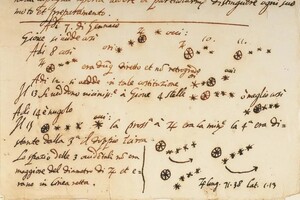The fake document was probably created in the 20th century by a well-known forger.

For a century, the University of Michigan kept a document that was considered “one of the pearls” of his library. It is believed that it was written by Galileo Galilei in 1609-1610. It contains a letter describing the telescope and sketches of Jupiter's moons. The university said it was “the first observational data to show that objects orbit a body other than Earth.”
Galileo did use the new telescope in 1610 to discover that Jupiter had moons orbiting it. This discovery helped to confirm the heliocentric model of Nicolaus Copernicus. At the same time, the university's investigation showed that Galileo most likely did not write the manuscript. The document was probably forged in the 20th century by a man named Tobia Nicotra, reports Smithsonian Magazine.
Read also: Einstein's manuscript sold at auction for $13 million
First doubts about authenticity document arose when Nick Wilding, a historian and Galileo researcher at Georgia State University, looked at a photo of the manuscript. He drew attention to the unusual handwriting, choice of words and color of the ink.
Wilding understands falsifications. He teaches the course “Forgeries, Facsimiles, and Fine Copies” at the University of Virginia School of Rare Books. He had previously discovered a forgery of Galileo's Sidereus Nuncius that allegedly included Galileo's original watercolors of the moon.
Pablo Alvarez of the Michigan Special Collections Research Center said he felt a “sense of devastation” when contacted Wilding and requested information on the provenance of the document, as well as an image of Galileo's watermark on the document.
Armed with this information, Wilding continued to investigate the manuscript and discovered that it was in the hands of Nicotra, a famous 20th-century counterfeiter. He also traced the watermark to the Italian city of Bergamo and discovered that it could be linked to a book titled Ancient Paper Mills of the Former Austro-Hungarian Empire and Their Watermarks. This book ended up in the possession of the library of the University of Michigan, and Wilding contacted local specialists and offered to look at it.
Alvarez did so. As a result, watermarks like the one found on the manuscript were not found until after 1770 – 160 years after the manuscript was written. Scientists have since concluded that the “Galileo manuscript” is a 20th-century forgery.
Related video
The university said in a statement that it is currently “reviewing the [manuscript's] place in the collection” and that it “may serve as a research, academic and teaching interests in the field of forgery and spoofing, a timeless discipline that has never been more relevant.”




